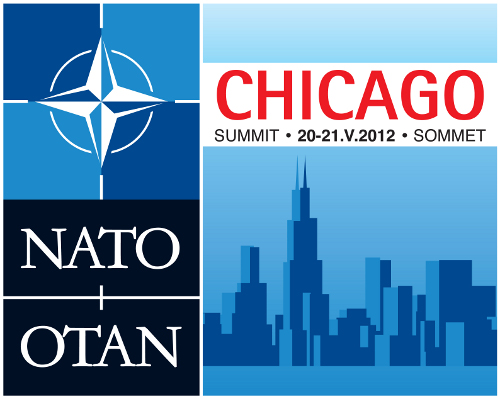
NATO’s summit in Chicago this weekend is unlikely to see much debate over the future of its controversial ‘out-of-area’ operations. Instead, prominent concerns over maintaining capabilities in an age of austerity will likely dominate the debate. This is a missed opportunity, as the last twelve months have been of unprecedented importance in shaping member countries’ thinking on these operations.
Some observers have hailed NATO’s recent military operation in Libya as a model intervention. With manageable levels of expenditure—both politically and resource-wise—Libya stands in stark contrast to the ‘Afghanistan model’ and the widespread fatigue the latter has provoked within the Alliance. However, as medium and long term security risks ripple through the region following the swift termination of the military engagement that contributed to the fall of the Qaddafi regime, NATO’s ‘mission accomplished’ in Libya is looking less persuasive. In turn, this calls the viability of future operations based on the ‘Libya model’ into question.
As the 2014 deadline for the transition from NATO to Afghan security forces approaches and the difficulties of stabilizing the country become ever more obvious, widespread disillusionment with respect to large-scale, prolonged military occupations comes as no surprise. The prevailing aversion to post-conflict stabilization is not only fuelled by the immediate experience of NATO’s quagmire in Afghanistan, it is further strengthened by current concerns over defense spending in times of economic and financial crisis, as well as by voters’ opposition to military engagements overseas.
Against this backdrop, a radically different model of intervention has been put to the test this past year. NATO’s Operation Unified Protector (OUP) in Libya—characterized by a narrow mandate, limited military objectives, and swift termination of military commitments—arguably reflected NATO’s concern to avoid further embroilment in post-conflict stabilization activities. OUP was undoubtedly more in line with prevailing public opinion and capacity constraints, thereby raising hopes about a new and potentially replicable model for out-of-area operations. Before concluding that this is the case, however, the following considerations should be taken into account.
First, in spite of growing disenchantment with post-conflict stabilization, it has become increasingly clear that ignoring the need for it altogether is not an option. The months following the termination of OUP in Libya provide a powerful, yet deplorable, confirmation. A weak central government and a barely functioning security sector, together with the proliferation of militias and the free flow of weapons, are turning the situation on the ground in Libya into a source of regional instability. Recent turmoil in Mali and its possible implications for neighboring countries in the Sahel zone are but one manifestation of this lingering threat.
Second, it has to be recognized that ‘mission accomplished’ cannot be pronounced on the basis of a short-term military success alone. The adoption of an overly ambitious political agenda, such as the elusive goal to ‘democratize’ a country, indeed sets the bar for successful intervention too high. Troops on the ground risk getting stuck in pursuit of unrealistic conditions for transition and disengagement. More limited mandates, such as stopping acute violence against the civilian population, however, must be balanced with a long-term strategic outlook that seeks to avoid broader regional repercussions.
Consequently, calls for prompt military withdrawal must be reconciled with measures for continued security assistance and cooperation. NATO’s withdrawal from Libya at the end of October 2011, against the wishes of the local authorities, should not have meant the end of its active engagement. In other words, declaring “mission accomplished” without providing parallel measures to prevent the post-conflict phase from spawning new threats to domestic and regional security and stability hardly represents an improved model for NATO’s out-of-area engagements.
Alternative policy options are unlikely to converge in a simple, clean model. However, they may emerge from a series of adjustments within an inevitably complex and sometimes contested framework. A first step in the right direction would be for NATO to invest in robust security sector reforms and commit to an active role in their implementation. To compensate for early withdrawal, NATO should further collaborate with other regional and international organizations and boost the latter’s role in post-conflict stabilization. In addition to facilitating external partnerships, member countries should coordinate internally to bring specialist expertise and individual resources to the table in the post-conflict phase.
Inevitably, this puts the issue of burden sharing back on the agenda. However, one of the lessons from OUP may well be that flexible arrangements within the alliance, which take into account both national prerogatives as well as differing levels of interest, can indeed be found.
In other words, the recipe to strengthen the ‘Libya model’ of intervention will require combining short term, limited, direct military engagement with longer term political, logistic, and technical support in the post-conflict stabilization phase. The upcoming NATO Summit should at the least remind member countries to continue searching for ways to do just that.
Andrea Barbara Baumann is a postdoctoral research fellow with the TAPIR Program at the Center for Transatlantic Relations at the School for Advanced International Studies, Johns Hopkins University. Benedetta Berti (@benedettabertiw) is a research fellow at the Institute for National Security Studies, a lecturer at Tel Aviv University and the co-author of “Hamas and Hezbollah: A Comparative Study” (Johns Hopkins University Press, 2012). The authors are members of the Atlantic Council’s Young Atlanticist NATO Working Group. This piece is part of a series of New Atlanticist pieces on NATO’s 2012 Chicago Summit.
Image: NATO-Chicago-Summit-Logo.jpg
